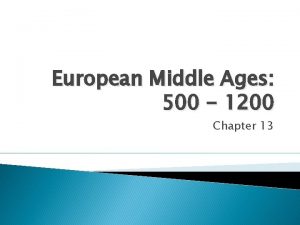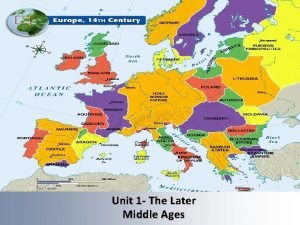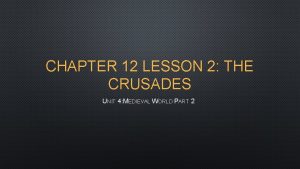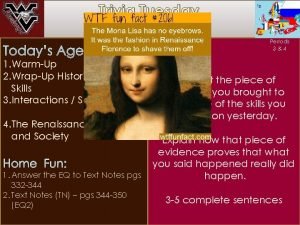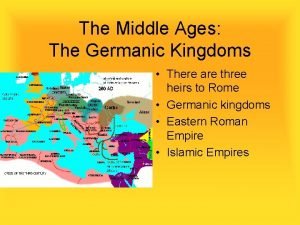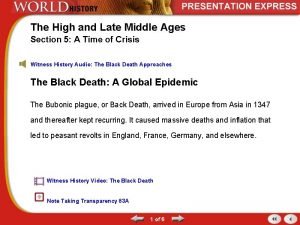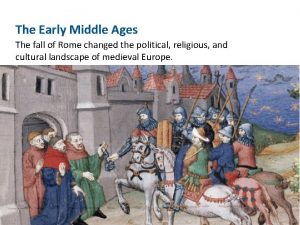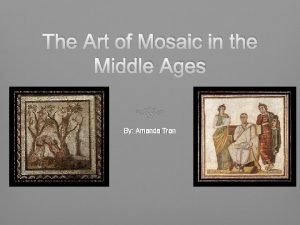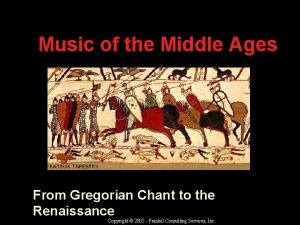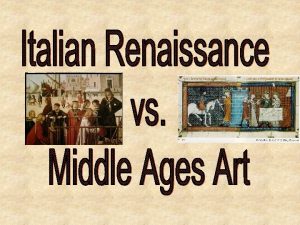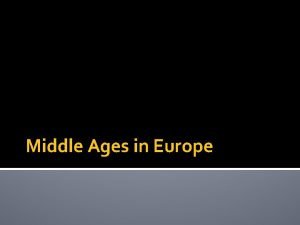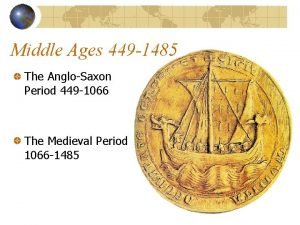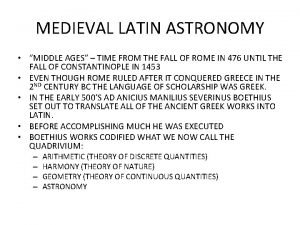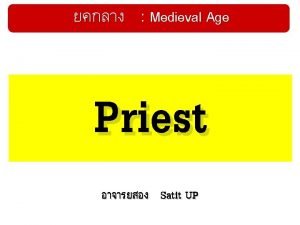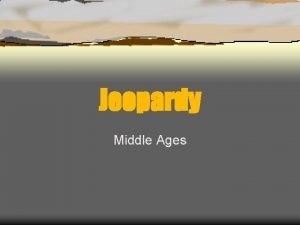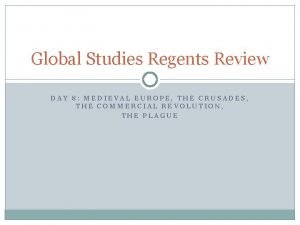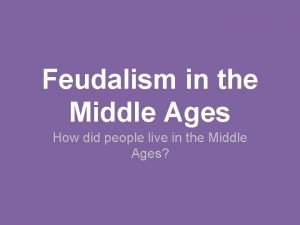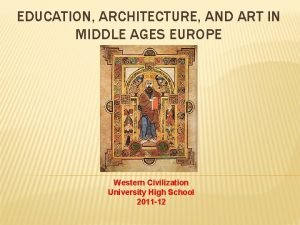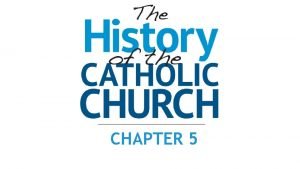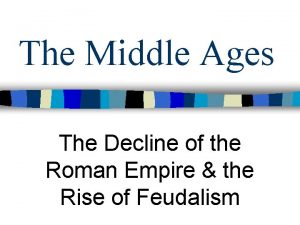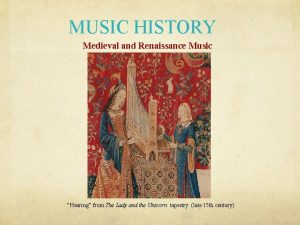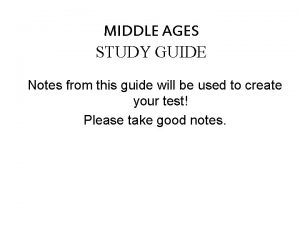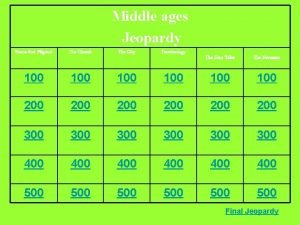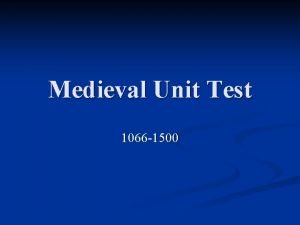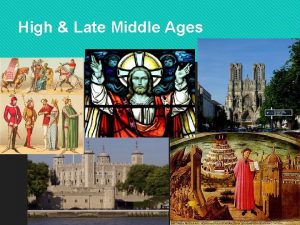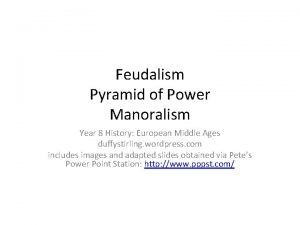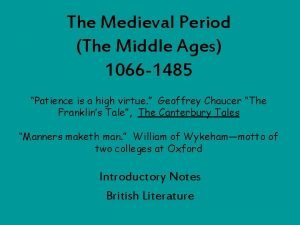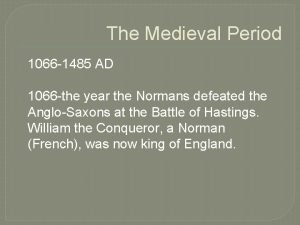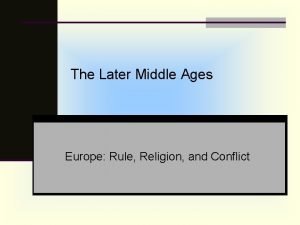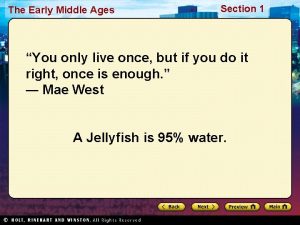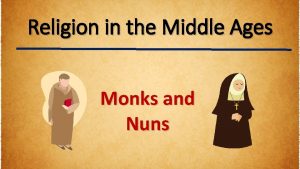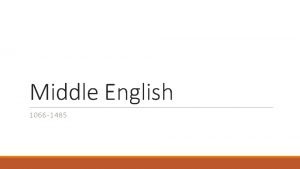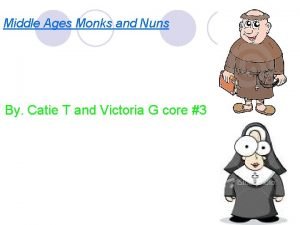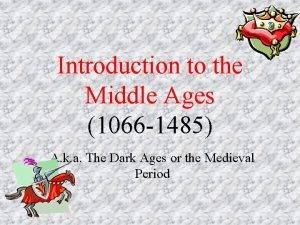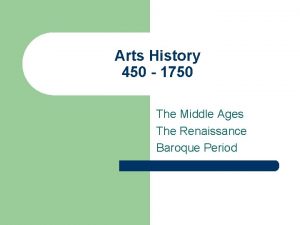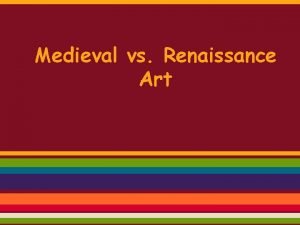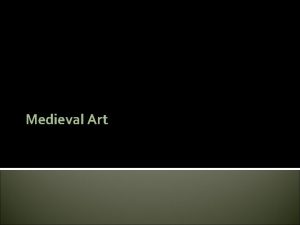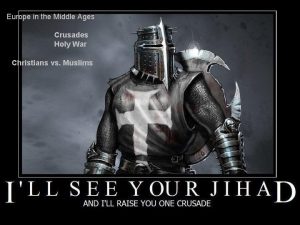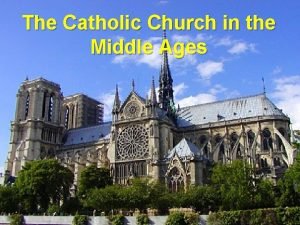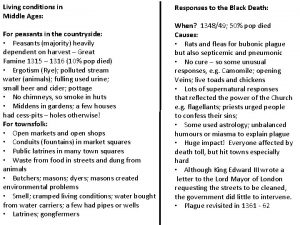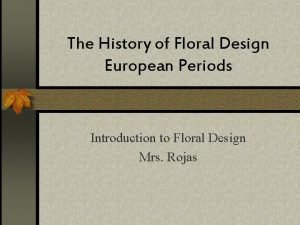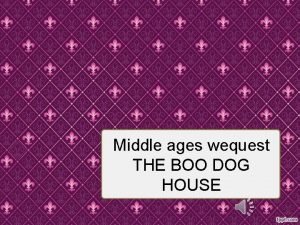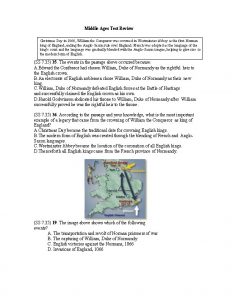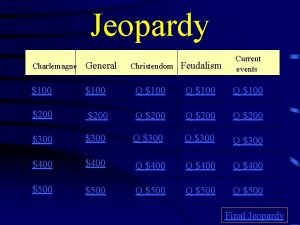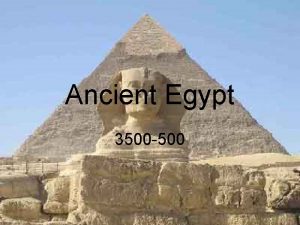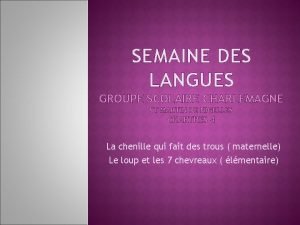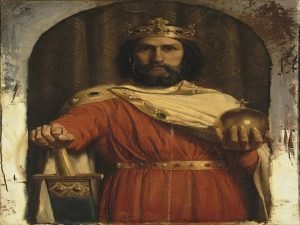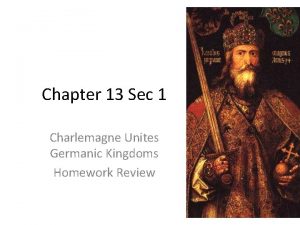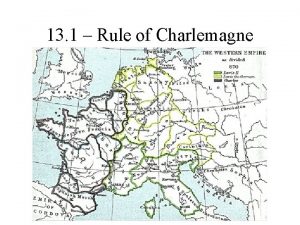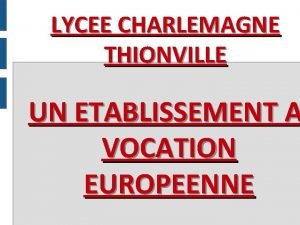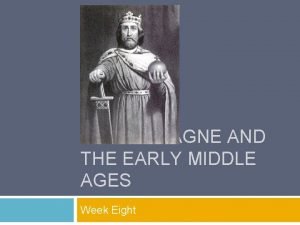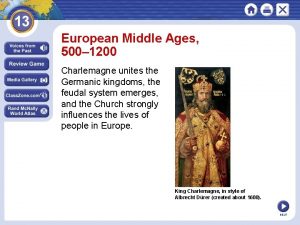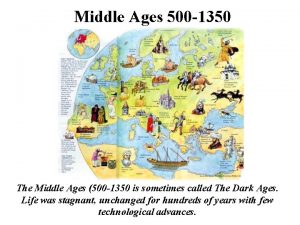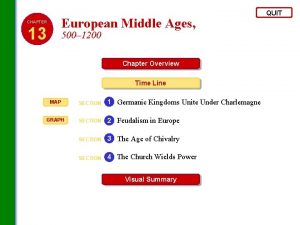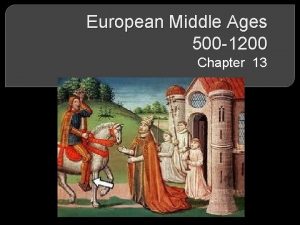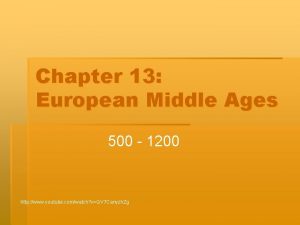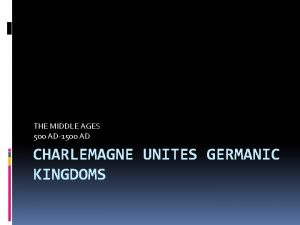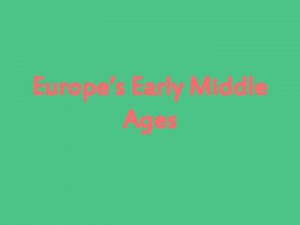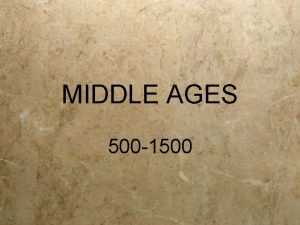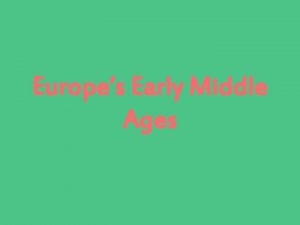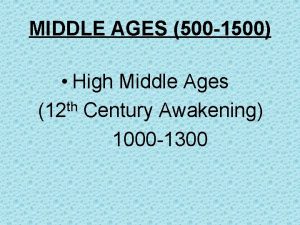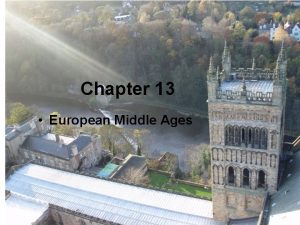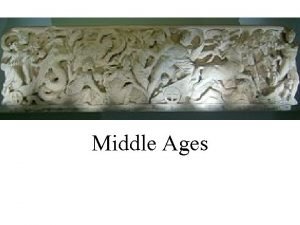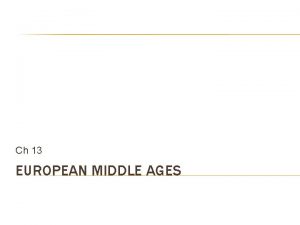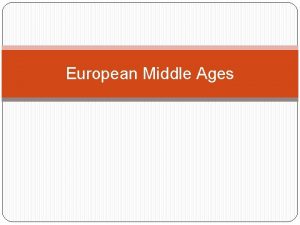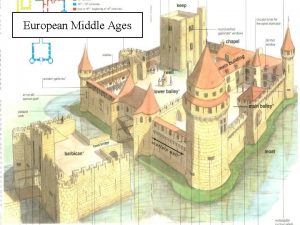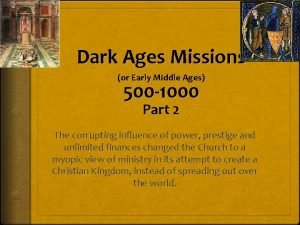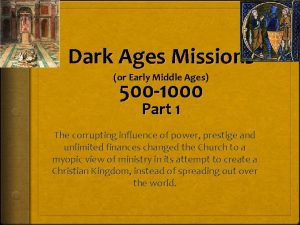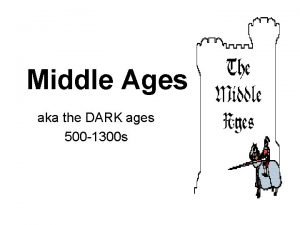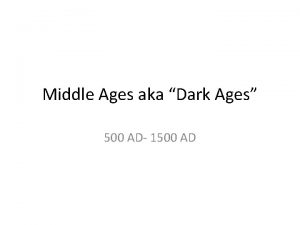European Middle Ages 500 1200 Chapter 13 Charlemagne

































































- Slides: 65

European Middle Ages: 500 - 1200 Chapter 13

Charlemagne Unites Germanic Kingdoms Chapter 13, Section 1

Middle Ages � 500 – 1500 � Also Medieval Period. � Society was based on: ◦ Classical heritage of Rome ◦ Beliefs of the Roman Catholic Church ◦ Customs of various Germanic tribes

Western Europe Invaded � Disruption of Trade ◦ Invasions cause businesses to collapse � Downfall of Cities ◦ Abandoned as centers of administration � Population Shifts ◦ Nobles retreat to rural areas; cities without leadership � Decline of Learning ◦ Invaders couldn’t read or write; Greek language almost lost � Loss of Common Language ◦ Latin not widely understood

Emerging Germanic Kingdoms � Small Germanic kingdoms replaced Roman provinces � Concept of government changed – no longer unified society and common law � No loyalty to unknown king; loyalty only to Germanic leader

Franks � Held power in Roman province - Gaul (today France / Switzerland) � Their leader, Clovis, converted to and brought Christianity to region � Began alliance between Church and Frankish kingdom.

Monasteries � Church built religious communities to adapt to rural areas ◦ Monks (men) lived in monasteries ◦ Nuns (women) lived in convents � Gave up private possessions and dedicated their lives to serving God � Became best-educated communities in Europe

Secular � Gregory I – became pope 590; authority as pope went beyond spiritual to secular (worldly) role: ◦ Papacy became involved in politics. ◦ Entered into peace treaties. ◦ Church income used to raise armies, fix roads AND help the poor. ◦ Claimed right to spiritual kingdom from Italy to England Spain to Germany. Pope Gregory I

Charles Martel � Mayor of Palace was most powerful position in Frankish kingdom; 719 position was held by Charles Martel. � Held more power than King Charles; extended Franks’ reign north, south and east; also defeated Muslim Raiders at Battle of Tours; became Christian hero.

Carolingian Dynasty � Son of Charles Martel, Pepin the Short, wanted to be king � Cooperated with pope to fight Lombards who threatened Rome. � Pope anointed Pepin as king, beginning Carolingian Dynasty that ruled 751 -987. Coronation in 752 of Pépin

Charlemagne (Charles the Great) known as Charles the Great; became king in 771. � Built enormous empire larger than Byzantine Empire, uniting entire Western Europe. � Spread Christianity; pope crowned him as “Roman Emperor”. � Managed kingdom and encouraged education. � Also

Feudalism in Europe Chapter 13, Section 2

Feudalism � Similar to feudalism in Japan. � Set of legal and military customs in medieval Europe. � Based on rights and obligations. � System for structuring society based the right to hold/work land in exchange for service or labor.

Feudalism: Terms � The noble who held land or landowner was called the lord. � The land granted to someone was called a fief. � The person receiving the land in exchange for services was the vassal.

Feudal Pyramid � Status in the feudal system depended on prestige and power. � At the peak was the king, and under him the vassals. � Knights served the landowners or vassals. � At base of pyramid was peasants and serfs.

Feudal Pyramid

Knights served under wealthy landowners or vassals. � They were mounted horsemen who pledged to defend their lord’s lands in exchange for fiefs (land). � The rank became associated with the ideals of chivalry, i. e. a code of conduct for the perfect courtly warrior. �

Serf Peasant or poor person who was required to work for the Lord of the Manor. � In return they were entitled to protection, justice and the right to use certain fields within the manor. � Often required not only to work on the lord's fields, but also his mines, forests and roads. � Serfs formed the lowest social class of feudal society. �

Manor � � � The area over which a lord had domain and could exercise certain rights and privileges in medieval Europe; 15 -30 families. The self-sufficient village would usually contain a church, workshops, fields, etc. where nearly everything the lord needed would be produced – crops, milk, cheese, cloth, leather, lumber. The Manor House was built apart from the village where the peasants lived.

Tithe � Peasant families were required to give up one tenth of their income or what they produced. � This was paid to the priest for the church.

The Age of Chivalry Chapter 13, Section 3

Chivalry Knights needed strength and skills to fight wars in the Middle Ages; they had to be disciplined and strong. � Followed a Code of Conduct that required chivalry – a set of expectations and ideals that included courtesy, generosity, justice and bravery. � Had to show loyalty to their feudal lord, heavenly lord and chosen lady. �

Tournament � Mock battle for knights to build experience in fighting. � Combined training and recreation; fierce and bloody competitions. � Winners could demand ransom from defeated knights.

Troubadour � Traveling poetmusicians who visited castles and courts of Medieval Europe. � Composed short verses and songs about joys and sorrows of love; would perform them for the ladies.

The Power of the Church Chapter 13, Section 4

Clergy � Included all church officials from the pope to bishops, priests and monks/nuns. � Power was based on status or rank within the church. � Priests were supervised by Bishops who also settled disputes amongst priests.

Sacrament � Sacred Christian rites or religious ceremonies.

Canon Law � Church Law � Authority of the Church was both religious and political. � EVERYONE – including royalty – subject to Canon Law. � Harsh punishments for offenders included excommunication and interdict.

Holy Roman Empire � Territories in medieval Germany ruled by Otto the Great. � Otto also invaded Italy on Pope’s behalf; was included in what became known as the Holy Roman Empire.

Lay Investiture � Appointment of bishops, abbots, and other church officials by feudal lords and vassals. � Banned by Church did not want royals to have that much power. � Led to clash between Pope Gregory VII and King Henry IV. Holy Roman Emperor Henry IV doing penance to reverse his excommunication by Pope Gregory VII

The Formation of Western Europe: 800 - 1500 Chapter 14

Church Reform and the Crusades Chapter 14, Section 1

Simony � The act of selling offices and positions in the Church. � Refers to the New Testament story where Simon Magus offered the apostles money for the gift of the Holy Ghost.

Gothic Architecture � Architects developed key techniques of structural engineering. � Features include: ◦ Ribbed vaults to support roof’s weight ◦ Flying buttresses that transferred weight to thick exterior walls ◦ Pointed arches that framed huge stained glass windows ◦ Tall spires that seemed to point to heaven

Pope Urban II � Turks massacred the Byzantine Empire’s armies; threatened Constantinople. � Pope Urban II urged revolt, marking beginning of Crusades. “A horrible tale has gone forth, ” he said. “An accursed race utterly alienated from God … has invaded the lands of the Christians and depopulated them by the sword, plundering, and fire. ” Toward the end, of his sermon he made his appeal: “Tear that land from the wicked race and subject it to yourselves. ”

Crusade � The Crusades were military campaigns or Holy Wars sanctioned by the Roman Catholic Church. � The first crusade tried to restore Christian access to holy places in and near Jerusalem.

Saladin � Powerful Kurdish leader who led the Muslim opposition to the Crusaders. � He united and lead the Muslim world; recaptured Jerusalem for the Muslims in 1187.

Richard the Lion-Hearted The pope, Gregory VIII, ordered another crusade to regain the Holy City for the Christians after Saladin’s victory. This was the start of the Third Crusade. � It was initially led by Richard I (Richard the Lion-Hearted), Emperor Frederick Barbarossa of Germany and King Philip II of France; eventually only Richard I remained. � Crusade lasted from 1189 to 1192; Richard 1 and Saladin signed truce. �

Reconquista The Reconquista is the name given to a long series of wars and battles between the Christian Kingdoms and the Muslim Moors � Battled for control of the Iberian Peninsula (Large part of Spain and Portugal today). � It lasted from 718 to 1492. � TOP: The division of the land before Granada was retaken. BOTTOM: The Moors surrendering to Ferdinand Isabella.

Inquisition � An organization in the Roman Catholic Church that was responsible for finding and punishing heretics (people who did not accept its beliefs and practices). � Targeted Jews and Muslims. � Involved torture, and if found guilty, burned at a stake.

Changes in Medieval Society Chapter 14, Section 2

Three-field system A system of land cultivation under which the common land is divided into three parts of which one or two in rotation lie fallow in each year and the rest are cultivated. � Increased food production; people were healthier because they could eat more and population expanded. �

Guild Organization of individuals in the same business / occupation. � Goal to improve economic and social conditions for members. � Merchants formed first guild to control trading prices and reduce losses. � Guilds later set standards for quality of work, wages and working conditions. �

Commercial Revolution � � � Expanded agriculture and trade changed way business was done; led to Commercial Revolution. No longer produced everything on self-sufficient manor. Fairs were set up to encourage trade of cloth, food (bacon, salt, honey, cheese, wine), leather goods, knives and ropes. Goods from foreign countries became available. Business and banking services developed.

Burgher A citizen of a borough or town, usually belonging to the middle class. � Did not fit in traditional order; resented interference from feudal lords. � Organized themselves into groups and demanded certain rights, e. g. right to govern a town. �

Vernacular � The language or dialect spoken by the ordinary people in a particular country or region � Different from main or official language; Shakespeare wrote his plays in vernacular spoken by ordinary people on the street.

Thomas Aquinas The Summary of Theology is considered to be Thomas Aquinas’ masterwork. � Combined theological principles of faith with the philosophical principles of reason to prove the existence of God. � Aquinas promoted the literal reading of Scripture (not allegorical interpretation). �

Scholastics � Men who met at universities and used their knowledge of Aristotle to debate issues of their time. � Teachings on law and government influenced Western Europeans; began development of democratic institutions and traditions.

England France Develop Chapter 14, Section 3

William the Conqueror � � Was also Duke of Normandy. After the death of William’s cousin Edward, Harold Godwinson claimed the throne of England for himself; William, angered by the betrayal, invaded England to enforce his claim to the throne. Crowned King of England after the Battle of Hastings in 1066. Laid groundwork for centralized government in England.

Henry II � English king who married Eleanor of Aquitine. � Obtained Aquitine in addition to Normandy; vastly expanded English territory within France.

Common Law � Under Henry II justice system improved. � Royal judges sent all across England; held jury trials. � Over years ruling of judges became “common law”. � Common law still basis for law in many English -speaking countries, including USA.

Magna Carta � Charter (contract between King John and nobles declaring all laws should be obeyed by everyone, including the king. � Limited power of the king and guaranteed certain rights for all citizens. � Basis for legal rights in England USA.

Parliament � Created by Edward I to raise taxes for warfare. � 2 burgesses (wealthy property owners) from each borough and two knights from each county served in this legislative group known as parliament.

Hugh Capet � After Carolingian Dynasty came to end, Hugh Capet took over small area in France that included Paris. � Began Capetian Dynasty – lasted 300+ years.

Philip II � Powerful Capetian – rulled 1180 – 1223 � Able to seize Normandy from English and extend French territory. � Established central government in France.

Estates-General � Consisted of: ◦ Church Leaders (1 st Estate) ◦ Great Lords (2 nd Estate) ◦ Commoners (3 rd Estate) � Eventually played huge role in overthrowing French monarchy during French Revolution

The Hundred Years’ War and the Plague Chapter 14, Section 4

Avignon � Pope Clement V moved from Rome to Avignon; popes lived there following 67 years. � Move away from Rome weakened Roman Catholic Church

Great Schism A split within the Catholic Church from 1378 to 1418. � Several men claimed to be the true pope. � Ended by the Council of Constance (1414– 1418). � The rival claims to the papal chair damaged the reputation of the office; weakened Catholic Church further. �

John Wycliffe � Challenged power of pope. ; preached that Jesus Christ was true head of the Church (not the pope). � Offended by wealth displayed by clergy. � Maintained Bible is final authority on Christ’s life. � Inspired translation of New Testament into English.

Jan Hus � Admired stance taken by John Wycliffe. � Maintained that authority of the Bible was higher authority than pope. � Excommunicated from Church – 1412 � Tried as heretic – 1414 � Burned at stake – 1415

Bubonic Plague / Black Death � � Epidemic started in Asia and spread across to North Africa and Europe in 1300’s. Deadly disease spread by rats; worsened by insanitary living conditions. Wiped out large sections of populations in China, North Africa and Europe. Many people believed that the Black Death was a kind of divine punishment for sins against God. Resulted in: ◦ Jews massacred ◦ Flagellation ◦ Pope’s power usurped

Hundred Years’ War � � Continuous battle between England France which eventually marked the end of the Middle Ages. Started initially because England’s Edward III claimed the right to the French throne in 1337. Continued for more than 100 years until 1453. Final outcome was that the French were able to drive England out of France (except for Calais), but it also brought about big changes in the way that wars were fought.

Joan of Arc � Joan of Arc led the French army to victory over the British at Orléans at age 18. � Captured a year later, Joan was burned by the English and their French collaborators as a heretic. � Canonized as a Roman Catholic saint 500 years later.
 500
500 Dark ages vs middle ages
Dark ages vs middle ages Dark ages vs middle ages
Dark ages vs middle ages European middle ages map
European middle ages map Chapter 12 lesson 2 world history
Chapter 12 lesson 2 world history Renaissance vs middle ages
Renaissance vs middle ages Germanic kingdoms
Germanic kingdoms Geometric mass design
Geometric mass design The high and late middle ages section 5 quiz
The high and late middle ages section 5 quiz Early middle ages
Early middle ages Mosaic middle ages
Mosaic middle ages Late middle ages timeline
Late middle ages timeline Gregorian chant composers
Gregorian chant composers Renaissance vs middle ages
Renaissance vs middle ages Feudalism def
Feudalism def A metaphorical phrase used to replace a concrete noun
A metaphorical phrase used to replace a concrete noun Astronomy in medieval times
Astronomy in medieval times Catholic clergy hierarchy
Catholic clergy hierarchy Middle ages jeopardy
Middle ages jeopardy What were two indirect results of the crusades
What were two indirect results of the crusades Feudal system in the middle ages
Feudal system in the middle ages Education in middle ages
Education in middle ages What word means rebirth
What word means rebirth Similarities between middle ages and renaissance
Similarities between middle ages and renaissance Middle ages def
Middle ages def Art of emerging europe meaning
Art of emerging europe meaning Middle ages
Middle ages The middle ages spans nearly one thousand years.
The middle ages spans nearly one thousand years. Middle ages study guide answer key
Middle ages study guide answer key Language answer
Language answer The middle ages 1066-1485 unit test
The middle ages 1066-1485 unit test English georgian period flower arrangements
English georgian period flower arrangements Copyright
Copyright Feudal system pyramid of power
Feudal system pyramid of power The middle ages outcome the power of the church
The middle ages outcome the power of the church Middle ages 1066 to 1485
Middle ages 1066 to 1485 The middle ages 1066-1485 unit test
The middle ages 1066-1485 unit test Early middle ages
Early middle ages Middle ages nobles
Middle ages nobles Sacred music of the middle ages
Sacred music of the middle ages Monks and nuns in the middle ages
Monks and nuns in the middle ages The middle ages 1066 to 1485 unit introduction
The middle ages 1066 to 1485 unit introduction Catiet
Catiet The middle ages 1066 to 1485 unit test closed book
The middle ages 1066 to 1485 unit test closed book Middle ages nobles
Middle ages nobles Middle ages
Middle ages Medieval art vs. renaissance art
Medieval art vs. renaissance art Middle ages art characteristics
Middle ages art characteristics Middle ages
Middle ages Medieval vs renaissance
Medieval vs renaissance Middle ages buildings
Middle ages buildings High middle ages
High middle ages Middle ages
Middle ages Living conditions in the middle ages
Living conditions in the middle ages European floral design history
European floral design history During the middle ages noblewomen had
During the middle ages noblewomen had Christmas day 1066
Christmas day 1066 Middle ages jeopardy
Middle ages jeopardy 3500 / 500
3500 / 500 Cite scolaire charlemagne
Cite scolaire charlemagne How did charlemagne die
How did charlemagne die Charlemagne unites germanic kingdoms
Charlemagne unites germanic kingdoms Charlemagne école
Charlemagne école Lycee charlemagne thionville
Lycee charlemagne thionville Photo charlemagne
Photo charlemagne Fin à la faim charlemagne
Fin à la faim charlemagne
